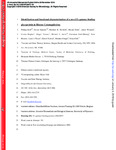Identification and functional characterization of a novel Fc gamma-binding glycoprotein in Rhesus Cytomegalovirus
| dc.contributor.author | Kolb, P | |
| dc.contributor.author | Sijmons, S | |
| dc.contributor.author | McArdle, MR | |
| dc.contributor.author | Taher, H | |
| dc.contributor.author | Womack, J | |
| dc.contributor.author | Hughes, C | |
| dc.contributor.author | Ventura, A | |
| dc.contributor.author | Jarvis, Michael A | |
| dc.contributor.author | Stahl-Hennig, C | |
| dc.contributor.author | Hansen, S | |
| dc.contributor.author | Picker, LJ | |
| dc.contributor.author | Malouli, D | |
| dc.contributor.author | Hengel, H | |
| dc.contributor.author | Früh, K | |
| dc.date.accessioned | 2019-02-02T16:29:33Z | |
| dc.date.available | 2019-02-02T16:29:33Z | |
| dc.date.issued | 2019-02-05 | |
| dc.identifier.issn | 0022-538X | |
| dc.identifier.issn | 1098-5514 | |
| dc.identifier.other | ARTN e02077-18 | |
| dc.identifier.uri | http://hdl.handle.net/10026.1/13267 | |
| dc.description.abstract |
Receptors recognizing the Fc part of immunoglobulin G (FcγRs) are key determinants in antibody-mediated immune responses. Members of the Herpesviridae interfere with this immune regulatory network by expressing viral FcγRs (vFcγRs). Human cytomegalovirus (HCMV) encodes four distinct vFcγRs that differ with respect to their IgG-subtype specificity and their impact on antibody-mediated immune function in vitro The impact of vFcγRs on HCMV pathogenesis and immunomodulation in vivo is not known. The evolutionary closest animal model of HCMV is rhesus CMV (RhCMV) infection of rhesus macaques. To enable the characterization of vFcγR function in this model, we studied IgG binding by RhCMV. We show that lysates of RhCMV-infected cells contain an IgG-binding protein of 30kDa encoded by the gene Rh05 that is a predicted type I glycoprotein belonging to the RL11 gene family. Upon deletion of Rh05, IgG-Fc binding by RhCMV strain 68-1 is lost whereas ectopic expression of Rh05 results in IgG binding to transfected cells consistent with Rh05 being a vFcγR. Using a set of reporter cell lines stably expressing human and rhesus FcγRs we further demonstrate that Rh05 antagonizes host FcγR activation. Compared to Rh05-intact RhCMV, RhCMVΔRh05 showed an increased activation of host FcγR upon exposure of infected cells to IgG from RhCMV-seropositive animals suggesting that Rh05 protects infected cells from opsonization and IgG-dependent activation of host FcγRs. However, antagonizing host FcγR activation by Rh05 was not required for the establishment and maintenance of infection of RhCMV, even in a seropositive host, as shown by the induction of T cell responses to heterologous antigens expressed by RhCMV lacking the gene region encoding Rh05. In contrast to viral evasion of NK cells or T cell recognition, the evasion of antibody-mediated effects does not seem to be absolutely required for infection or re-infection. The identification of the first vFcγR that efficiently antagonizes host FcγR activation in the RhCMV genome will thus permit more detailed studies of this immunomodulatory mechanism in promoting viral dissemination in the presence of natural or vaccine-induced humoral immunity.IMPORTANCE Rhesus cytomegalovirus (RhCMV) offers a unique model for studying human cytomegalovirus (HCMV) pathogenesis and vaccine development. RhCMV infection of non-human primates greatly broadened the understanding of mechanisms by which CMVs evade or re-program T cell and NK cell responses in vivo. However, the role of humoral immunity and viral modulation of anti-CMV antibodies has not been studied in this model. There is evidence from in vitro studies that HCMVs can evade humoral immunity. By gene mapping and with the help of a novel cell-based reporter assay system we characterized the first RhCMV encoded IgG-Fcɣ binding glycoprotein as a potent antagonist of rhesus FcγR activation. We further demonstrate that, unlike evasion of T cell immunity, this viral Fcγ receptor is not required to overcome anti-CMV immunity to establish secondary infections. These findings enable more detailed studies of the in vivo consequences of CMV evasion from IgG responses in non-human primate models. | |
| dc.format.extent | e02077-e02018 | |
| dc.format.medium | Electronic-Print | |
| dc.language | en | |
| dc.language.iso | en | |
| dc.publisher | American Society for Microbiology | |
| dc.subject | Fc receptors | |
| dc.subject | antibody function | |
| dc.subject | cytomegalovirus | |
| dc.subject | immune evasion | |
| dc.subject | immunology | |
| dc.subject | rhesus | |
| dc.subject | virology | |
| dc.title | Identification and functional characterization of a novel Fc gamma-binding glycoprotein in Rhesus Cytomegalovirus | |
| dc.type | journal-article | |
| dc.type | Journal Article | |
| dc.type | Research Support, N.I.H., Extramural | |
| dc.type | Research Support, Non-U.S. Gov't | |
| plymouth.author-url | https://www.ncbi.nlm.nih.gov/pubmed/30487278 | |
| plymouth.issue | 4 | |
| plymouth.volume | 93 | |
| plymouth.publication-status | Published | |
| plymouth.journal | Journal of Virology | |
| dc.identifier.doi | 10.1128/JVI.02077-18 | |
| plymouth.organisational-group | /Plymouth | |
| plymouth.organisational-group | /Plymouth/Faculty of Health | |
| plymouth.organisational-group | /Plymouth/Faculty of Health/School of Biomedical Sciences | |
| plymouth.organisational-group | /Plymouth/REF 2021 Researchers by UoA | |
| plymouth.organisational-group | /Plymouth/REF 2021 Researchers by UoA/UoA01 Clinical Medicine | |
| plymouth.organisational-group | /Plymouth/Research Groups | |
| plymouth.organisational-group | /Plymouth/Research Groups/Institute of Translational and Stratified Medicine (ITSMED) | |
| plymouth.organisational-group | /Plymouth/Research Groups/Institute of Translational and Stratified Medicine (ITSMED)/CBR | |
| plymouth.organisational-group | /Plymouth/Users by role | |
| plymouth.organisational-group | /Plymouth/Users by role/Academics | |
| dc.publisher.place | United States | |
| dcterms.dateAccepted | 2018-11-26 | |
| dc.rights.embargodate | 2019-5-28 | |
| dc.identifier.eissn | 1098-5514 | |
| dc.rights.embargoperiod | Not known | |
| rioxxterms.versionofrecord | 10.1128/JVI.02077-18 | |
| rioxxterms.licenseref.uri | http://www.rioxx.net/licenses/all-rights-reserved | |
| rioxxterms.licenseref.startdate | 2019-02-05 | |
| rioxxterms.type | Journal Article/Review |


